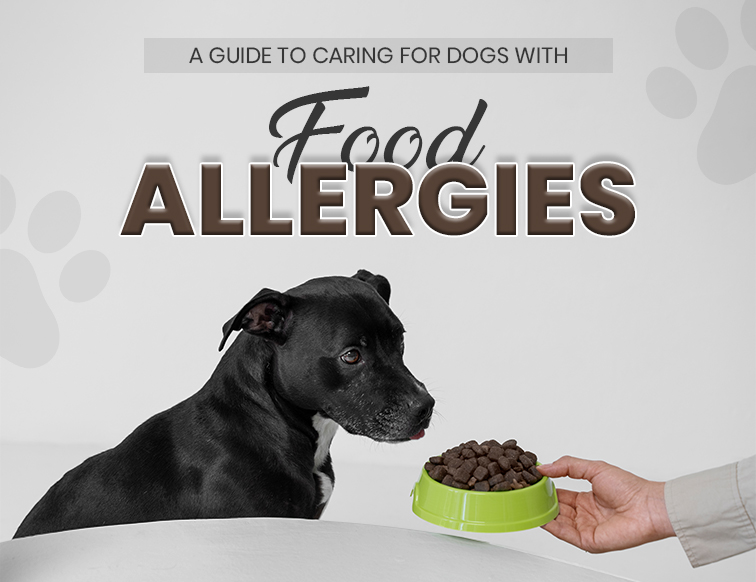A Guide to Caring for Dogs with Food Allergies

Watching your beloved dog struggle with itchy skin, an upset tummy, and unexplained discomfort can be heart-wrenching and perplexing. You may not realize, but the culprit can also be in their food bowl—yes, we mean their food. Food allergies in dogs are more common than you may think, and navigating them is not that straightforward. They can develop at any stage of life, and identifying the specific allergens is nothing short of a challenge.
In this informative guide, we’ll walk you through everything you need to know, from recognizing the symptoms to diagnosis and caring for a dog with food allergies. Having this knowledge will help you navigate this condition better and provide ideal support to ensure a healthy and discomfort-free life for your pet.
Let’s get started with the fundamentals!
What is Food Allergy in Dogs?
Food allergy is basically your dog’s immune system responding to specific ingredients in their diet, typically a protein or carbohydrate. These ingredients are called allergens, and when the dog is exposed to a food item containing such allergens, their immune system registers it as a foreign substance and overreacts. This can cause a reaction ranging from skin problems to gastrointestinal issues.
Food allergies in dogs are common and can manifest at any stage of life. Mostly, they are observed to emerge after prolonged exposure to a particular food or ingredient. Since these reactions are unique to specific dogs and can occur due to different food items, narrowing down to specific allergens is quite challenging.
For your reference, here are some commonly recognized food allergies in dogs:
- Eggs
- Wheat
- Chicken
- Beef
- Dairy
- Soy
What are the Common Symptoms of Food Allergy?
Now, we’ll discuss the common symptoms of food allergies in dogs. Being aware of these will help you identify the issue early and save your beloved dog from a great deal of discomfort:
Skin issues:
- Excessive scratching & licking
- Itching
- Frequent ear/skin infections
- Hot spots
- Hair loss
- Redness
Gastrointestinal issues:
- Vomiting
- Diarrhea
- Excessive gas
- Lethargy
- Appetite loss
- Abdominal discomfort
Other issues:
- Hives
- Facial swelling
- Weight loss
How are Food Allergies Identified?
There is no specific method to identify the allergens causing food allergies in dogs. So, professionals rely on various approaches, which are:
Medical history: In this method, veterinarians study the medical history of the dog to find clues about potential food allergens. This also includes a physical examination and an inquiry about the symptoms to understand the onset of the allergic reaction.
Laboratory tests: Some blood and saliva tests help measure the amount of antibodies (IgE) to specific food proteins to detect food allergies. However, these tests are not considered very reliable for diagnosis.
Elimination diet: It’s the most practiced and reliable method for diagnosing food allergies in dogs. In an elimination diet, the dog is fed a novel protein and carbohydrate source or a hydrolyzed diet for 8-12 weeks. Then, the old diet is gradually reintroduced with individual items to identify the culprit allergen.
How to Care for Dogs with Food Allergies?
Ideally, food allergies in dogs cannot be cured, but they can be managed. It involves various strategies, including diet management, vet guidance, treatments, and supplements. Let’s explore these further in this segment.
Diet management
Providing a balanced diet devoid of allergens is the best way of managing food allergies in dogs. You can introduce proteins your dog has never been exposed to before and see how it work, or prepare home-cooked meals under the guidance of a nutritionist. Furthermore, feeding hydrolyzed protein diets is also a good option, as they are less likely to trigger the immune overreaction.
Controlling secondary issues
While dealing with food allergies, you can help your dog deal with the discomfort by focusing on controlling the secondary issues. You can administer suitable treatments, after consulting with your vet, to soothe symptoms such as itching, vomiting, diarrhea, etc.
Dietary supplements
Once you are aware of the allergens, you can plan a diet that excludes these harmful ingredients. However, this may leave holes in your pet’s nutrition since the diet plan would be very specific.
So, adding supplements can be a great way to fulfil your dog’s specific nutritional requirements in case the diet is falling short. Do your research and consult your vet to ascertain the right supplements for your dog.
Long-term management
Ongoing monitoring is essential for the long-term management of food allergies in dogs. Maintain close contact with your vet and nutritionist and take regular follow-ups to make dietary adjustments, manage secondary symptoms, and monitor new sensitivities (if any).
For long-term management, you also need to be wary of other allergies caused by environmental factors or infections by parasites. So, take timely measures by administering the right flea and tick treatments and reducing exposure to environmental allergens, including pollen, dust, dander, etc.
Explore a wide collection of highly effective flea and ticks treatments from premium brands at exciting prices and ensure your beloved pet’s protection against pesky parasites.
Parting Words
Food allergies in dogs can be complex, with so many factors to consider. But with the right knowledge, you can effectively manage them. We hope this guide has provided clarity on the signs, causes, and management of canine food allergies. For the best outcome, always consult your vet, as they will provide expert and personalized advice. With professional guidance, patience, and proper care, you can help your pet lead a safe, healthy, and comfortable life.
